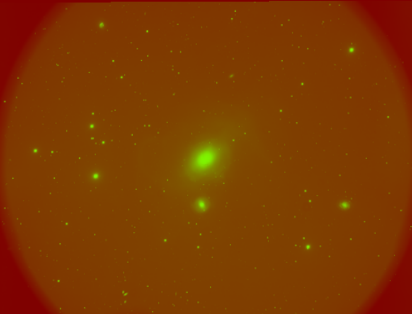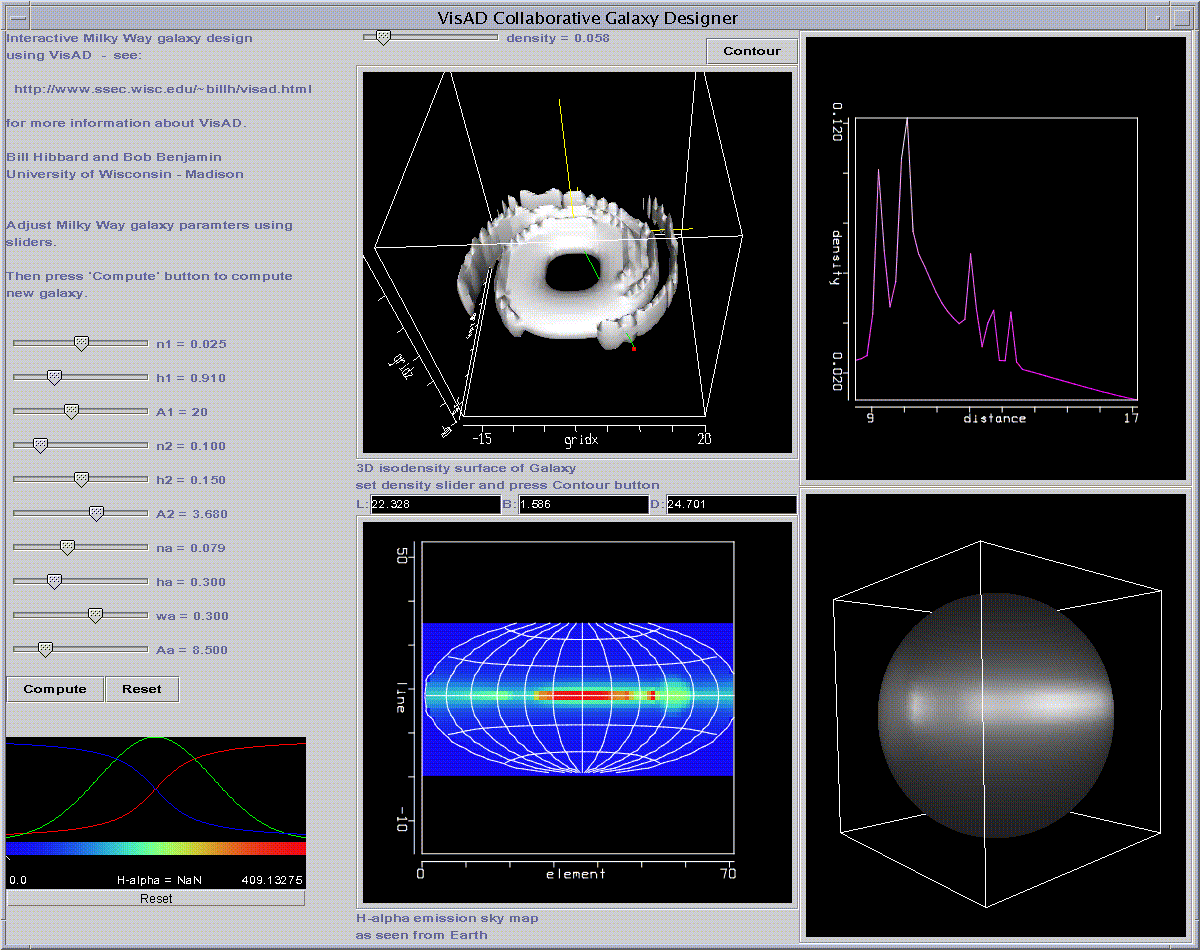Introduction
VisAD is a Java class library for interactive and collaborative visualization and analysis of numerical data. It combines:- The use of pure Java for platform independence and to support data sharing and real-time collaboration among geographically distributed users. Support for distributed computing is integrated at the lowest levels of the system using Java RMI distributed objects.
- A general mathematical data model that can be adapted to virtually any numerical data, that supports data sharing among different users, different data sources and different scientific disciplines, and that provides transparent access to data independent of storage format and location (i.e., memory, disk or remote). The data model has been adapted to netCDF, FITS, HDF-EOS, McIDAS, Vis5D, GIF and JPEG file formats.
- A general display model that supports interactive 3-D, data fusion, multiple data views, direct manipulation, collaboration, and virtual reality. The display model has been adapted to Java3D and Java2D and used in an ImmersaDesk virtual reality display.
- Data analysis and computation integrated with visualization to support computational steering and other complex interaction modes.
- Support for two distinct communities: developers who create domain- specific systems based on VisAD, and users of those domain-specific systems. VisAD is designed to support a wide variety of user interfaces, ranging from simple data browser applets to complex applications that allow groups of scientists to collaboratively develop data analysis algorithms.
- Developer extensibility in as many ways as possible.
Join the VisAD mailing list
There is a VisAD mailing list. To subscribe to it send an email message to majordomo@ssec.wisc.edu withsubscribe visad-list
as the first line of the message body. You can also subscribe to visad-list-digest if you only want a daily summary of messages to visad-list. To unsubscribe, send email to majordomo@ssec.wisc.edu with
unsubscribe visad-list
as the first line of the message body.
Check out Unidata's visad-list archive.
How to get VisAD
VisAD is freely available including complete source code, documentation and application examples from:- Download the VisAD source code as a jar file (you may need to click on the jar file with the SHIFT key held down to get your browser to load it).
The VisAD Java Class Library Developers Guide is the key document for understanding how to use VisAD. It is available in the following forms:
Other doumentation includes: VisAD is also available as jar files containing compiled classes. The classes of all VisAD packages are available as a jar file (you may need to click on the jar file with the SHIFT key held down to get your browser to load it). See the README file for installation instructions.
If you are in Europe
The Deutsches Klimarechenzentrum has offered to serve as a mirror site for our software. The VisAD files are available from this ftp directory.
The VisAD Spread Sheet
The VisAD Spread Sheet is a handy way to visualize and compute with netCDF, FITS, GIF, JPEG, Vis5D, McIDAS and HDF-EOS files, that does not require any programming. Of course, the full flexibility of VisAD is only accessible to programmers using the class library, but the Spread Sheet is a useful tool and a nice illustration of what you can do programming with the VisAD class library.
Prerequisites
VisAD requires Java 2 which is freely available from Sun's Java 2 web page.Displays may be generated with either Java2D (included in Java 2) or Java3D, which is freely available from Sun's Java3D web page.
Java3D requires OpenGL. You can freely download OpenGL for Sparc Solaris and for Windows 95. OpenGL is standard with Windows NT.
Support for File Formats
VisAD includes support for accessing data in various file formats, including:- FITS
- netCDF
- HDF-EOS - see the README.hdfeos file for instructions for installing the HDF-EOS native libraries
- Vis5D - you can dowload the libvis5d.so native method library (for Sparc Solaris) into your visad/data/vis5d directory (remember to add .../visad/data/vis5d to your LD_LIBRARY_PATH)
- McIDAS
- GIF
- JPEG
- VisAD (serialized VisAD data objects)

Collaborative Milky Way Galaxy Designer
Here's a screen shot of a collaborative Milky Way galaxy design application using VisAD:

The goal is to adjust parameters of the Milky Way galaxy to get the H-alpha sky map (shown in a flat map projection and on a sphere) to match observations made from Earth. Users can drag the red point in the 3-D galaxy density display and see a graph of density versus distance along a line between the red point and the sun. This application serves as a good example of how to build collaborative applications using VisAD and is freely available including complete source code as part of the VisADF distribution.
See the README.benjamin file for further instructions.
Collaboration Between an ImmersaDesk and a Workstation
We produced a demonstration of collaboration between an ImmersaDesk and a workstation for the NCSA Alliance '98 conference. This combined VisAD, NCSA Habanero, and an adaptation of Java3D to the ImmersaDesk by Steve Pietrowicz and Chris Heistad of the NCSA Java3D Group. Check out this mpeg movie of VisAD interaction in the ImmesaDesk.This demonstration is based on the GoesCollaboration application written using VisAD. GoesCollaboration serves as a good example of how to build collaborative applications using VisAD. It is included in the VisAD source distribution in the visad/paoloa directory. However, the application needs two data files to run, data_obs_1.dat and goesrtcf, available in this:
See the README.paoloa file for more information.Click here for a screen shot of this application.
Prototype Environmental Hydrology Workbench
Here's a screen shot and description of the prototype environmental hydrology workbench demonstrated at Supercomputing 98, and developed as part of the NCSA Environmental Hydrology team effort. It uses VisAD and Globus.
Collaborative Computational Steering Example
The 2-D shallow fluid model lets you experiment with physical and numerical parameters of the simulation and visualize the consequences. It lets groups collaborate in these experiments. It is included in the VisAD source distribution in the visad/aune directory. See the README.aune file for more information.
Digital Elevation Model Viewer for ArcGrid ASCII export files
Check out the DEMViewer, developed by Ugo Taddei of the Department of Geoinformatics, Geohydrology and Modelling of the Institute of Geography of the University of Jena, Germany. DEMViewer uses VisAD to interactively visualize hydrology information. There are some cool images on its web page.
Rainfall Estimation Custom SpreadSheet
The Rain.java program in the visad/rabin directory is the start of an application for estimating rainfall from satellite images. It features links between cells for panning and zooming, for color tables, and for a custom cursor for reading out pixel values. To run the Rain program, download the data set in the dallas_2.5km_v5d.v5d file (you may need to click on this file with the SHIFT key held down to get your browser to save it on your disk), then run:
java visad.rabin.Rain dallas_2.5km_v5d.v5dNote this application requires the native library for reading v5d files and so only runs on Sparc Solaris.
Hyper-spectral Data from NEST-I
The Nasti.java program in the visad/paoloa directory is the start of an application for analyzing hyper-spectral data from the NEST-I sensor. To try it, download a NEST-I data set in the smc3ars1.nc file (you may need to click on this file with the SHIFT key held down to get your browser to save it on your disk), then run:
java visad.paoloa.Nasti smc3ars1.ncClick and drag the right mouse button on the yellow cursor in the image display to select a pixel for the spectral display. Click and drag the right mouse button on the red cursor in the spectral display to select a wave number for the image display.
Equinox: an Information Mining Example
Equinox is an information mining tool that utilizes machine intelligence applied to natural language processing to significantly enhance the innovative discovery process. Equinox uses VisAD.
Custom Texture Mapping Example
Lutz Laemmer has created an extension of DataRenderer for customized texture mapping.
Interactive Earth Globe Example
Steve Emmerson has created an interactive globe display of Earth topography and bathymetry using VisAD. It is included in the VisAD source distribution as the visad/examples/Earth.java class. You'll need to download the netCDF topography file into your visad/examples directory (you may need to click on this file with the SHIFT key held down to get your browser to save it on your disk), then run:
java -Xmx64m Earth lowresTerrain.nc
Image Stretching Applet Example
Curtis Rueden has written an image stretching applet using VisAD.
Interactive Curve and Surface Fitting
The Spline and Spline2D applications distributed with VisAD in the visad/paoloa/spline directory let you experiment with various statistical curve and surface fitting algorithms. The red dots are draggable, to experiment with the effect of noise on fitting algorithms.
Year 2000 Statement of Compliance for VisAD
VisAD is Year 2000 compliant. It includes one class, DateTime, for doing date and time computations, that uses 32-bit integer years. Specifically, VisAD does not include any logic with two-digit years.
Article about VisAD in August 1998 Computer Graphics
The article: gives a good overview of the VisAD system.
Other Information
You may be interested in two papers presented at the January 1997 AMS IIPS conference:
- Java and the World Wide Web: The Right Choice for Interactive Systems available as postscript and ascii
- A Java and the World Wide Web Implementation of VisAD available as postscript and ascii
To contact the authors...
Email can be sent to Bill Hibbard at whibbard@macc.wisc.edu.Postal mail can be sent to:
Bill Hibbard Space Science and Engineering Center University of Wisconsin - Madison 1225 W. Dayton St. Madison, WI 53706If you create extension packages to VisAD we will be happy to add links to your web page describing and serving your extensions.
Disclaimers
VisAD is free software and as such we do not provide real support for it. However, we will be happy to answer short questions and/or help with minor problems (preferably by email).Java, JDK, and Jump to Java: JDK 1.2 Launch Logo are trademarks or registered trademarks of Sun Microsystems, Inc. in the U.S. and other countries.
P.S.
We also have a home page for Vis5D.
